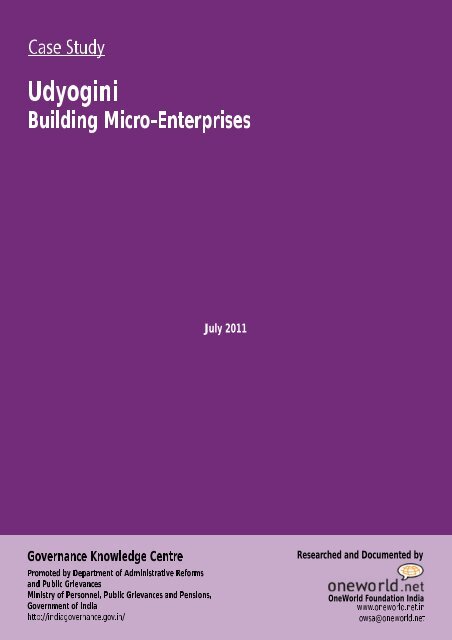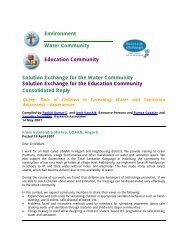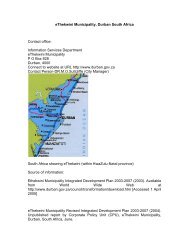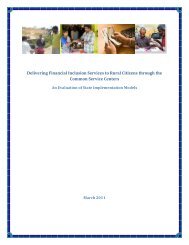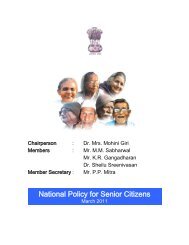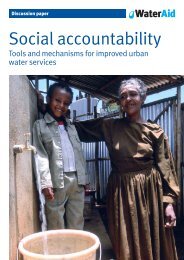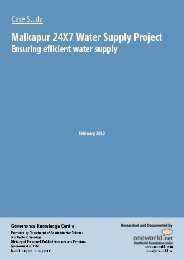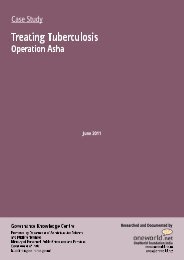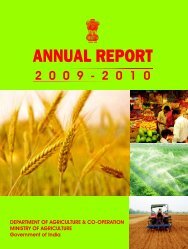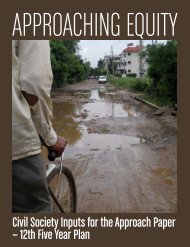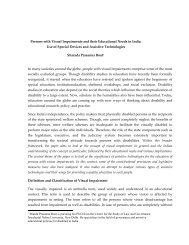See full case study - Indiagovernance.gov.in
See full case study - Indiagovernance.gov.in
See full case study - Indiagovernance.gov.in
Create successful ePaper yourself
Turn your PDF publications into a flip-book with our unique Google optimized e-Paper software.
Governance Knowledge CentrePromoted by Department of Adm<strong>in</strong>istrative Reforms and Public GrievancesM<strong>in</strong>istry of Personnel, Public Grievances and PensionsGovernment of IndiaCase StudyWomen EmpowermentUdyog<strong>in</strong>i: Build<strong>in</strong>g Micro-EnterprisesTRANSPARENCY AND ACCOUNTABILITYJuly 2011Executive SummaryParticularly <strong>in</strong> develop<strong>in</strong>g societies, women’s work has historically been conf<strong>in</strong>ed to thehousehold. In rural India, women regularly contribute to farm labour and generat<strong>in</strong>g <strong>in</strong>comeat the subsistence level. Such <strong>in</strong>come generat<strong>in</strong>g activities <strong>in</strong>clude those as varied ascollect<strong>in</strong>g, sell<strong>in</strong>g and process<strong>in</strong>g m<strong>in</strong>or forest produce, embroider<strong>in</strong>g on textiles and leatherand mak<strong>in</strong>g baskets from local varieties of grass. At the same time, women have not receivedtheir share of education, tra<strong>in</strong><strong>in</strong>g, health and livelihood opportunities that are consistent withtheir potential, which will enable them to deal with crises and improve their well-be<strong>in</strong>g. Inan <strong>in</strong>creas<strong>in</strong>gly market-ascendant ascendant world, severe constra<strong>in</strong>ts have been created to susta<strong>in</strong>ablelivelihoods for poor, asset-lessand ma<strong>in</strong>ly illiterate women <strong>in</strong> the backward states of India.Market uncerta<strong>in</strong>ties often result <strong>in</strong> reduced <strong>in</strong>comes and lesser number of days ofemployment for them.Udyog<strong>in</strong>i, a non-<strong>gov</strong>ernmental organization (NGO) based <strong>in</strong> New Delhi, came <strong>in</strong>to existence<strong>in</strong> 1992 with the belief that solutions for such problems need to go ‘beyond credit’ and shouldbe ones that build women’s access, knowledge and capacity <strong>in</strong> a variety of ways. It works toempower the poor and socially marg<strong>in</strong>alized women with adequate skills and resourcesnecessary for develop<strong>in</strong>g and manag<strong>in</strong>g micro-enterprises. Udyog<strong>in</strong>i has done this byprovid<strong>in</strong>g Bus<strong>in</strong>ess Development Services (BDS) to them directly or to the organizationswork<strong>in</strong>g with them.Udyog<strong>in</strong>i’s two flagship programmes are the Tra<strong>in</strong><strong>in</strong>g of Enterprise Support Teams (TEST) -for professionals and para-professionals professionals who want to work <strong>in</strong> microenterprise developmentbut do not yet have the bus<strong>in</strong>ess skills to do so- and Grassroots Management Tra<strong>in</strong><strong>in</strong>g (GMT)-designed to help marg<strong>in</strong>alized women become entrepreneurs and not just skilled producers.It works by establish<strong>in</strong>g strategic partnerships with public and private agencies for elevat<strong>in</strong>gtheir operations <strong>in</strong> order to <strong>in</strong>crease the scale and scope of three core ‘products’- value cha<strong>in</strong>development, market l<strong>in</strong>kages and enterprise and entrepreneurship tra<strong>in</strong><strong>in</strong>g.By 2010, Udyog<strong>in</strong>i had tra<strong>in</strong>ed over 1500 enterprise promot<strong>in</strong>g staff from NGOs and<strong>gov</strong>ernment with a comb<strong>in</strong>ed GMT eligible base of almost 50,000 women. For their directlyimplemented enterprise promotion programmes at the grassroots- called ‘From Mobilizationto Market’- Udyog<strong>in</strong>i selects locations that are challeng<strong>in</strong>g and where women are notsupported for micro enterprise work <strong>in</strong> any significant measure by the <strong>gov</strong>ernment or NGOs.Udyog<strong>in</strong>i currently operates <strong>in</strong> Uttarakhand (Dehradun, Chamoli), Rajasthan (Udaipur,Bikaner, Pugal), Bihar (Patna, Kishanganj), Assam (Goalpara), Jharkhand (Ranchi, Khunti),Orissa (Keonjhar, Rayagada), and Madhya Pradesh (Jabalpur, Mandla, Chih<strong>in</strong>dwara).2Researched and documented byOneWorld Foundation India
Governance Knowledge CentrePromoted by Department of Adm<strong>in</strong>istrative Reforms and Public GrievancesM<strong>in</strong>istry of Personnel, Public Grievances and PensionsGovernment of IndiaCase StudyWomen EmpowermentUdyog<strong>in</strong>i: Build<strong>in</strong>g Micro-EnterprisesTRANSPARENCY AND ACCOUNTABILITYJuly 2011support compris<strong>in</strong>g tra<strong>in</strong><strong>in</strong>g for enterprise awareness, management and counsell<strong>in</strong>g, to move<strong>in</strong>to develop<strong>in</strong>g microenterprise programs and hav<strong>in</strong>g staff with orientation to microenterprise.URMUL, SURE and LUPIN <strong>in</strong> Rajasthan, NIPDIT and Samanwita <strong>in</strong> Orissa and ADITHI <strong>in</strong>Bihar, are NGOs that have grown and now established microenterprise programs.Udyog<strong>in</strong>i aims at greater market control at the hands of women. It looks at such capacitybuild<strong>in</strong>g <strong>in</strong> terms of two stages- livelihood security and enterprise growth. In the former stage,women who are <strong>in</strong>volved <strong>in</strong> rudimentary <strong>in</strong>come-generat<strong>in</strong>g activities are provided tra<strong>in</strong><strong>in</strong>g tohelp them understand market channels and operations, requirements for undertak<strong>in</strong>gsusta<strong>in</strong>able microenterprises, and cop<strong>in</strong>g mechanisms are put <strong>in</strong> place for them to deal withchang<strong>in</strong>g market conditions. The latter stage is marked by development of an entrepreneurialcapacity <strong>in</strong> women, understand<strong>in</strong>g of markets beyond the local ones, and lesser dependence ofwomen on wage labour s<strong>in</strong>ce enterprises beg<strong>in</strong> to yield enough <strong>in</strong>come for them to act as theprimary source of earn<strong>in</strong>g.Udyog<strong>in</strong>i’s field programmes are headed by team leaders operat<strong>in</strong>g out of field offices. It hasseparate offices for BDS and state-wide clients <strong>in</strong> every state. Its staff members near 60 <strong>in</strong>number and are mostly located <strong>in</strong> state offices. Udyog<strong>in</strong>i is headed by a Chief Executive Officerand its operations are managed by a Chief Operat<strong>in</strong>g Officer. It has a separate BDS Manager <strong>in</strong>Delhi who forms the BDS team along with BDS managers <strong>in</strong> the states. Enterprise PromotionManagers are <strong>in</strong>-charge for an enterprise; they are assisted by field assistants. Udyog<strong>in</strong>i isfunded largely by <strong>in</strong>ternational donors, the Government of India and corporate houses.ObjectiveUdyog<strong>in</strong>i aims to provide quality, appropriate and timely bus<strong>in</strong>ess development services fortra<strong>in</strong><strong>in</strong>g and promotion of poor women as entrepreneurs.Work<strong>in</strong>g DesignUdyog<strong>in</strong>i works <strong>in</strong> regions that are backward and ‘enterprise starved’ and ma<strong>in</strong>ly <strong>in</strong> sectorswhere there is a concentration of women workers. Its work started with work<strong>in</strong>g <strong>in</strong> the field ofagriculture and non-timber forest produce ow<strong>in</strong>g to its operations <strong>in</strong> tribal areas where peopleare engaged ma<strong>in</strong>ly <strong>in</strong> these sectors. These are not enterprise-driven areas of work; Udyog<strong>in</strong>i’swork started with the aim of <strong>in</strong>tegrat<strong>in</strong>g these activities with the market- a significantly crucialgoal particularly keep<strong>in</strong>g <strong>in</strong> m<strong>in</strong>d the ascendancy of the market <strong>in</strong> India <strong>in</strong> early 1990s.The focus areas of Udyog<strong>in</strong>i’s work are gender and poverty, market-oriented capacity build<strong>in</strong>gfor producers, cater<strong>in</strong>g to both subsector and multi-sector bus<strong>in</strong>ess service requirements,4Researched and documented byOneWorld Foundation India
Governance Knowledge CentrePromoted by Department of Adm<strong>in</strong>istrative Reforms and Public GrievancesM<strong>in</strong>istry of Personnel, Public Grievances and PensionsGovernment of IndiaCase StudyWomen EmpowermentUdyog<strong>in</strong>i: Build<strong>in</strong>g Micro-EnterprisesTRANSPARENCY AND ACCOUNTABILITYJuly 2011programme to go digital. It is hoped that digitalization would help national-level scal<strong>in</strong>g up ofthe programme.Udyog<strong>in</strong>i has recently ently collaborated with the Aditya Birla Group and ACC Cement for itsprogrammes <strong>in</strong> Madhya Pradesh.c. Government agenciesUdyog<strong>in</strong>i has worked with the forest departments under the <strong>gov</strong>ernments of Rajasthan andMadhya Pradesh <strong>in</strong> World Bank-funded projects such as the District Poverty Initiatives Project.Currently, Udyog<strong>in</strong>i works closely with the National Bank for Agriculture and RuralDevelopment (NABARD) <strong>in</strong> Rajasthan, MP and Jharkhand.d. International organizationsInternational organizations are <strong>in</strong>volved <strong>in</strong> Udyog<strong>in</strong>i’s <strong>in</strong>itiatives ma<strong>in</strong>ly <strong>in</strong> the capacity ofdonor bodies. These <strong>in</strong>clude Oxfam, Action Aid, UNIFEM, Ford Foundation, DfID and UNDP.Currently, Udyog<strong>in</strong>i is closely work<strong>in</strong>g with UNDP <strong>in</strong> the field of child care <strong>in</strong>itiatives <strong>in</strong> UttarPradesh.Programme ImpactBy 2010, Udyog<strong>in</strong>i had tra<strong>in</strong>ed over 1500 enterprise promot<strong>in</strong>g staff from NGOs and<strong>gov</strong>ernment with a comb<strong>in</strong>ed GMT eligible base of almost 50,000 women. While its work hasexpanded to 7 states <strong>in</strong> the country, Madhya Pradesh and Rajasthan have been among its oldestand most successful <strong>in</strong>itiatives. Initiatives <strong>in</strong> Jharkhand are currently undergo<strong>in</strong>g <strong>in</strong>tensivedevelopments and show much promise.In 2010, Udyog<strong>in</strong>i completed six years of its operations <strong>in</strong> agriculture and non-timber forestproducts collection and trade <strong>in</strong> Madhya Pradesh and covered 3000 women <strong>in</strong> 100 villages with135 skilled BDS providers. A VLSC <strong>in</strong> the non-timber forest produce and agriculture valuecha<strong>in</strong> was piloted <strong>in</strong> Mandla <strong>in</strong> 2009. Improved returns and bus<strong>in</strong>ess viability have encouragedpurchase of assets that contribute to the growth of the bus<strong>in</strong>ess (e.g., wireless phone connectionto get <strong>in</strong>formation on market prices from CLSC and for rent<strong>in</strong>g out to village users like a publiccall facility). As per Udyog<strong>in</strong>i’s records <strong>in</strong> 2010, knowledge of market prices has enabled 40 percent of participat<strong>in</strong>g households to <strong>in</strong>crease their marg<strong>in</strong>s on produce by sell<strong>in</strong>g to the VLSCand CLSC. 20 per cent of participat<strong>in</strong>g households have <strong>in</strong>vested <strong>in</strong> vegetable cultivation fornutritional benefit for the household. 10 per cent of these households have been able to acquirelivestock where previously they had none. Children of 5 per cent of families have reducedvulnerability to serious illness because of the additional money available for curative services.10Researched and documented byOneWorld Foundation India
Governance Knowledge CentrePromoted by Department of Adm<strong>in</strong>istrative Reforms and Public GrievancesM<strong>in</strong>istry of Personnel, Public Grievances and PensionsGovernment of IndiaCase StudyWomen EmpowermentUdyog<strong>in</strong>i: Build<strong>in</strong>g Micro-EnterprisesTRANSPARENCY AND ACCOUNTABILITYJuly 2011iii.Is there any tra<strong>in</strong><strong>in</strong>g provided to people <strong>in</strong>volved <strong>in</strong> these groups? If yes, please providedetails- type, duration, the agencies <strong>in</strong>volved, and follow<strong>in</strong>g up procedures.6. Monitor<strong>in</strong>g and evaluationi.Is there any monitor<strong>in</strong>g mechanism <strong>in</strong> place to assess the impact of Udyog<strong>in</strong>i’s<strong>in</strong>itiatives?a. If yes, how are performance <strong>in</strong>dicators identified?b. How is the monitor<strong>in</strong>g data collected? What is the frequency of data collection?c. How is the data utilized?7. F<strong>in</strong>ancial modeli.Udyog<strong>in</strong>i’s work<strong>in</strong>g model is capital <strong>in</strong>tensive. How is the revenue generated? What arethe major heads under which it is spent? Please give an approximate break-down ofcosts per month or annum for each.ii. Is there a revenue generat<strong>in</strong>g aspect to the model, that is, is there a direct return onUdyog<strong>in</strong>i’s f<strong>in</strong>ancial <strong>in</strong>vestment <strong>in</strong> the programmes? If yes, how does that operate? Ifno, how is the function<strong>in</strong>g susta<strong>in</strong>ed?Impact8. Could you provide examples where Udyog<strong>in</strong>i’s programme has been highly successful andwhere it has not succeeded as per expectations? What are the exact reasons for both?9. Are there any other <strong>in</strong>itiatives <strong>in</strong> the plann<strong>in</strong>g phase?10. Please provide current programme achievement figures.i. Number of states and districtsii. Number of partnersiii.Approximate return that various <strong>in</strong>itiatives are generat<strong>in</strong>giv.Number of VLSCs and CLSCsv. Overall number of women the <strong>in</strong>itiatives impactvi.Has there been any measured effect of these <strong>in</strong>itiatives on human development factors<strong>in</strong> the regions- education level, employment rate etc?15Researched and documented byOneWorld Foundation India


